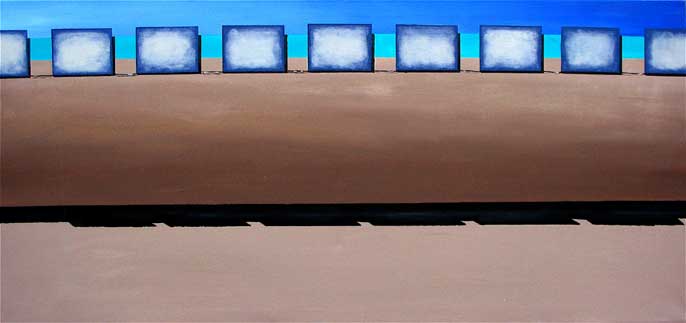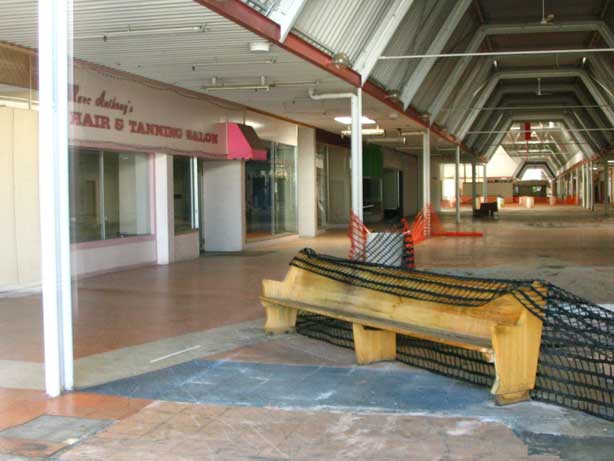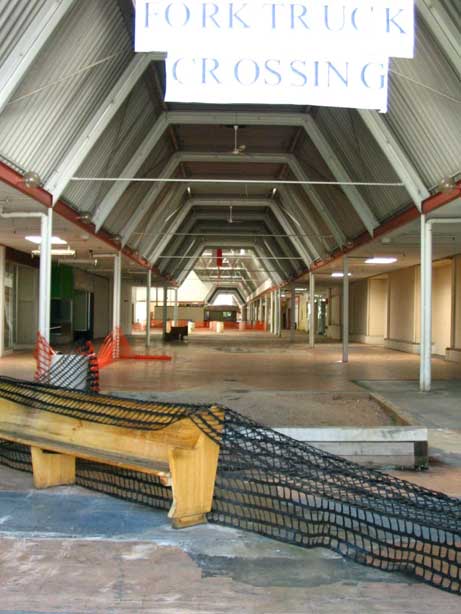 |
  
Forsaken
Sanctuaries (or The Death of Shopping)
They
were places of worship where kids grew up, got their first jobs, and spent
their first paychecks. Places where
families went for the day to catch a movie, have lunch, spend money and above
all – people watch. The Mall: that was
the place to be, a mecca whether you were a pre-teen or a senior citizen. Everything you needed was in one convenient,
temperature-controlled environment: food, clothing, music, a warm pleasant
environment, and other people.

On
a particular warm, crisp, and bright morning, I found myself driving around
North Versailles. North Versailles is
situated east of Pittsburgh, with the famed Lincoln Highway (Route 30) running
right though town. This town is mostly
residential; visible are the remnants of many defunct businesses. While cruising around the various shells of
commercialism’s past and the small
squat 1940’s- and 50’s-style one-story homes nestled and packed into the
typical western Pennsylvanian hilly landscape, the view opened up and I
suddenly was confronted with the hulking New Eastland Mall. Imagine a wide expanse of empty and decaying
parking lot, and, in the center, a large blocklike structure, almost like some
sort of overgrown Stonehenge.
The
Eastland Shopping Plaza was built in the early 1960s, changing its name to
Eastland Mall after a 1973 fire led to extensive renovations. The flea market has been a mainstay at the
mall for the past 15 years, but in accordance with natural mall evolution, it
was closed early in 2005. A few cars
can be seen here and there, either using the parking lot as a short cut or
parked for unknown reasons.
I
then set myself to the task of spending time in this location, understanding
it, learning about it, and really looking at it.
I
spent most of the summer of 2005 photographing and painting on-site and,
ironically enough, being thrown out of the site twice for “loitering”. Apparently, though pretty much abandoned,
the Mall still had a caretaker who took it upon himself to drive around in his
van making sure the local riff-raff stayed out. In spite of the place
being locked up tight and having no real reason for anybody to be there or even
want to be there, people were told to leave. As a result, all photographs and paintings were done of either the
exterior or by peering in the windows, while keeping an eye on the caretaker’s
van.

I
did manage to enter the old movie theater via the back door, which had been
previously pried open. As is apparent
in the photographs, the style and decor of the theater is in the exact same
style of the New Eastland Mall, although it is a separate building set off from
the rest of the mall. The interior was
demolished with remnants of the business of the theater everywhere. The smell of mold ran thick through the
entire structure. While in complete and
utter disarray, everything was intact – seats, posters, counters, right down to
the strewn empty popcorn boxes over the rich red carpeting. The individual theaters (there were only two
screens) still had all of their seats and screens, yet these areas too were
severely damaged. Oddly enough, seemly
the best composed photograph of the whole place was taken blind. The camera’s flash was turned on and then
pointed into the dark theater at random. Only by processing the photos did the deep interior of the theater
become visible for the first time.

Back
outside, senior citizens could still be seen doing “laps” around the mall for
exercise. That was allowed as long as
you kept moving. The deep irony of the
“walkers” was that they were no longer allowed to do the traditional climate
controlled laps around the inside of the mall like they had for years. Now they were relegated to doing their laps
on the outside – around the edge of the parking lot.
Another
strange aspect of this mall was the absence of graffiti. There was not a mark anywhere on this
structure despite the hundreds of square feet of clean and open potential tag
space. The presence of a caretaker who
was at the site on a part-time basis at best was not a graffiti deterrent. For graffiti artists, he would be easy to
avoid. It is something else that keeps
this place devoid of any kind of life.

All
this leads to the inevitable question: what happens to large spaces such as
this now that they stand empty? Some of
them get demolished, but others just remain a blight on the suburban landscape.
Invariably, each mall goes through the natural evolution of "mall
death". Stores start pulling out
of their leases, less than upscale stores take over for a short while, local
stores hang on. Eventually, there are
more empty stores than full. Then the
obligatory Flea Market arrives and takes over the space on the weekends. For the owner of the mall, any revenue is
better than none. Eventually, the flea
market goes away and we are left with an empty hulking space.

While
some malls are still thriving and others are merely hanging on, the majority of
these types of malls are abandoned now. Large sprawling buildings surrounded by equally large parking lots sit
in the middle of suburban wastelands. How these places came to be deserted is no mystery. The "big box" stores offering very
cheap prices and a high selection of items drove the malls right out of
business. We all go to them: Wal-Mart,
Target, Ikea... the list goes on. The
one thing that these box stores lack is what the malls offered: a place of
social gathering. While every square
inch of a Target store is coordinated with merchandise and no space is wasted,
missing are places to sit, relax or socialize.
Indoor
malls had open social communal areas. The first indication that malls were on the decline was the appearance
of merchant kiosks that sprouted up in the communal spaces. Mall owners found it harder to keep revenue
coming in, and it wasn’t working as well as it used to with the traditional
store format. As damage control, they
began to lease “spots” in the hallways for kiosk vendors. Go into any mall today and those formerly
open communal areas are all jammed with kiosks of small vendors. The sad part about it is that in some malls,
the kiosks are standing empty just like many of the stores. So gone are the communal spaces; customers
need to get in and get out so the stores can maximize their profits as much as
possible. People who hang out are just
taking up space.
The
New Eastland Mall is not an oddity. This is happening to malls all over the United States. Malls that are still in operation and were
previously financially strong now show signs of struggle. One mall that is starting to exhibit signs
of decline is the Monroeville Mall. Upon a recent visit to this mall, I noticed a large amount of empty
stores and unused kiosks. This mall is
still officially “thriving”, partly due to its location – Monroeville is a huge
draw for all kinds of shopping, from strip malls to fast food restaurants to
big box stores to traditional indoor malls. But upon a recent visit inside the
Monroeville Mall, I counted ten empty
store spaces upon a stroll down one level of the mall – not a good sign for
such a large shopping icon of Monroeville. Throw in the fact that Kauffman’s, Southwestern Pennsylvania's
sophisticated shopping juggernaut, recently left the mall to be replaced by a
Boscov’s Department store, a kind of Kohl’s-meets-JC
Penney-meets Sam’s Club.
So
what does this mean for the mall, shopping, and ultimately, human interaction
in general? Small stores and boutiques
are pretty much doomed from the get go. Our society is looking for products from a
larger, cheaper, quicker venue. Traditional “shopping” is dead. Our society appears to be finished with the casual, interactive way of
shopping in years past. Shopping has
now to been transformed into
researching what we want on the internet, hopping in the SUV to the big box
store, getting the item(s) and returning home as fast as possible. A large portion of society (myself included)
skips that last part entirely and will wait for purchases to arrive in the
mail, thus eliminating any last thread of social interaction available by going
to a traditional mall. (The reader can
feel free to substitute the word “shopping” with the phrase “human interaction”
anywhere in this piece.)
 |
Is
this a good or a bad development? The jury is still out. What is obvious is that there has been a
change – a shift in our habits. Because
of this change in habits, we are left with are large areas of suburban blight
that just sit and decay. Unsuitable for
sale or renovation, these buildings are sometimes razed, perhaps for home
development, assuming that the particular tracts of land they occupy are in
desirable locations. Most of the time,
they are not.
Suburban
blight is unlike urban blight. Urban
spaces often have the flexibility to change, to be renovated to suit a current
need. Dead Malls don’t have that
luxury. They are specific spaces, built
so large, and often in a very particular style, that it is almost impossible to
renovate them for new purposes – the cost would be phenomenal. It is easier just to raze these structures
and reallocate the space they occupied for something else.
|
While
the malls stand as forgotten fossils, they are also testaments to what we are: consumers. These relics mark an end of an era. The phasing out of social interaction and
time spent with others gives rise to a "get in, get out, get it done, and
move on to something else" mentality. This would imply that we are a busier society. This is a myth. We would
like to think we are “busier.” It makes us feel more important, more
productive, somehow better than our predecessors. We have, however, just shifted our priorities more from the
social to the individual; from personal interactions to the self check-out; and
from calling on others for help to checking out BN.com for the latest self-help
book.
Shopping
at a local mall takes time, patience and just a little bit of legwork. Our society today has less patience and is
growing larger and larger in girth. We
are looking for a quick fix, a fast pill, or a drive up window to solve our
issues with one big gesture. It appears
that we have lost the understanding of one big basic principle that our mamas
told us: in life, you gotta’ shop
around.
For
more information on dead and dying malls, check out the following links:
www.deadmalls.com
www.laforum.org/deadmalls/
www.easternct.edu/depts/amerst/MallsHistory.htm

Lauren Zito is
a faculty member of both Duquesne University and at the Art Institute of
Pittsburgh. She teaches Studio Art and Graphic Design. She recently had a
one-woman exhibition at the Box Heart Gallery in Bloomfield earlier this year
and works primarily with oil paints and occasionally mixed media. Not a native
of Pittsburgh, she hails from Maine, but found herself in the iron city about
eight years ago and has been a firmly ensconced ever since. More verbal
meanderings of Ms. Zito can be heard on "20 Minutes with Lord Dacron"
podcast at http://lorddaycron.libsyn.com/.
Website of more of your artwork: http://web.mac.com/toolgirl150/iWeb.
|
 |